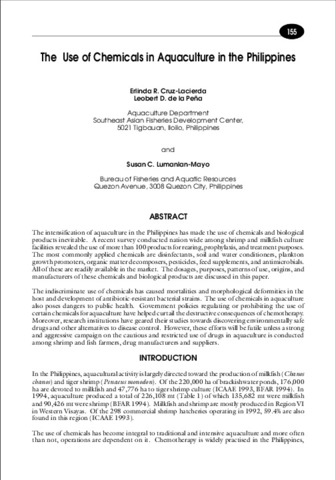The use of chemicals in aquaculture in the Philippines
Share
Abstract
The intensification of aquaculture in the Philippines has made the use of chemicals and biological products inevitable. A recent survey conducted nation wide among shrimp and milkfish culture facilities revealed the use of more than 100 products for rearing, prophylaxis, and treatment purposes. The most commonly applied chemicals are disinfectants, soil and water conditioners, plankton growth promoters, organic matter decomposers, pesticides, feed supplements, and antimicrobials. All of these are readily available in the market. The dosages, purposes, patterns of use, origins, and manufacturers of these chemicals and biological products are discussed in this paper.
The indiscriminate use of chemicals has caused mortalities and morphological deformities in the host and development of antibiotic-resistant bacterial strains. The use of chemicals in aquaculture also poses dangers to public health. Government policies regulating or prohibiting the use ofcertain chemicals for aquaculture have helped curtail the destructive consequences of chemotherapy. Moreover, research institutions have geared their studies towards discovering environmentally safe drugs and other alternatives to disease control. However, these efforts will be futile unless a strong and aggressive campaign on the cautious and restricted use of drugs in aquaculture is conducted among shrimp and fish farmers, drug manufacturers and suppliers.
Suggested Citation
Cruz-Lacierda, E.R., De la Peña, L.D., & Lumanlan-Mayo, S.C. (2000). The use of chemicals in aquaculture in the Philippines. In J. R. Arthur, C. R. Lavilla-Pitogo, & R. P. Subasinghe (Eds.), Use of Chemicals in Aquaculture in Asia: Proceedings of the Meeting on the Use of Chemicals in Aquaculture in Asia, 20-22 May 1996, Tigbauan, Iloilo, Philippines (pp. 155-184). Tigbauan, Iloilo, Philippines: Aquaculture Department, Southeast Asian Fisheries Development Center.


